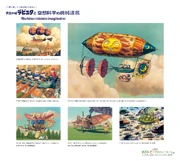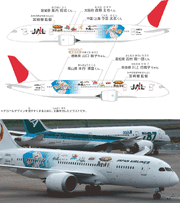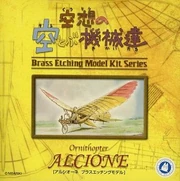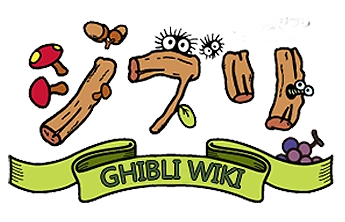Imaginary Flying Machines (空想の空飛ぶ機械達 , Kūsō no Sora Tobu Kikaitachi) is a 6-minute animated short film produced by Studio Ghibli for their exclusive use in the Ghibli Museum in Mitaka, Tokyo. It was screened from October 2, 2002 to May 9, 2004 and featured director Hayao Miyazaki as the narrator, in the form of a humanoid pig, reminiscent of Porco from "Porco Rosso".
The film is about the story of flight and the many machines imagined to achieve it.[1] Many of the designs depicted are flying machines as imagined by 19th century European artists. One such influence is French artist Albert Robida, who would become one of the main sources of inspiration for the designs of "Howl's Moving Castle". It produced for the temporary exhibition "Laputa, The Castle in the Sky and Imaginary Science Fiction Machines".[2]
It has screened intermittently in Japan Airlines (JAL) "Fly in the Sky" schedule, a program that began in July 2007. A companion 35mm film, "The Invention of Imaginary Machines of Destruction", was produced and directed by renowned director and former Ghibli animator Hideaki Anno and shown in a "film box" in the Ghibli Museum.
Synopsis
It was man's dream since the ancient past to fly the great skies freely as a bird. People imagined various ways of flying and thought up flying vehicles that moved by manpower or by the powers of science. All the manpowered planes, airbaloons, and ornithopters are creating a huge traffic jam in the sky! Even with the advanced aviation technology today, the desire to fly the great skies have not ceased.

Stills from "Imaginary Flying Machines" featuring the advancements of airships.
The film is unique in that Hayao Miyazaki appears as an anthropomorphic pig character, introducing the flying machines that first appeared in "Laputa: Castle in the Sky" and various "flying machines" that were inspired by artists in 19th century science fiction.
According to Miyazaki's avatar, flying freely in the sky has long been a longing for humankind, and before the advancement of science and technology, it relied on magic or human power. However, with the invention of various machines due to the development of science, people came to believe that they could fly anything by reducing the weight of engines and gears and increasing the number of propellers, and many unusual things in 19th century European scientific novels.
The Ghibli Museum guide book features stills from the film, including the ending with the Pazu-like character about to take flight.
Throughout the film, various flying machines make an appearance. Airships that fly through the air on oars, balloons that open and close parasols, airplanes in the shape of bats and fish, wooden flying boxes that take electricity from the air, propeller armored ships of aerial pirates, aerial taxis that fly freely in the city, etc. All manner of bizarre vehicles fill the sky, reminiscent to the opening to "Laputa: Castle in the Sky". Many of these designs are reminiscent of works by Jules Verne and Albert Robida are seen.
Eventually, these fantastical flying machines evolve steadily into the technology we see in the real world, and now anyone can travel by air. Time passes and passenger airships give way to futuristic space craft that can be all across the sky. Miyazaki's avatar steps into one such airships, and we see images of what it must be like being in one of them.
The film then poses the question, has humanity's desire to fly in the sky been fulfilled? No, now and in the future, humanity's longing for the sky will never disappear. At the end of the story, a boy who who resembles Pazu from "Laputa: Castle in the Sky" takes off into the sky on the red and white ornithopter called "Alcione".
Behind the Scenes
Cover of "Twentieth Century" by French artist Albert Robida.
The first animated short created solely for the Ghibli Museum. "Fantasy Sky Flying Machines" is a short animation produced for the exhibition "Laputa, The Castle in the Sky and Imaginary Science Fiction Machines" at the Ghibli Museum in Mitaka. It was screened in a mini theater set up in the exhibition hall. Unfortunately, the screening of this work was discontinued at the end of the special exhibition, and can no longer be viewed by anyone. Ever.
This film featured various vehicles that have inspired Hayao Miyazaki throughout his career. Many of the machines depicted stem from 19th century novels and various illustrations and designs by Albert Robida. It was animated traditionally and then manipulated with 3D to create realistic and complex movements while preserving the 2D hand-crafted texture. This technology that fused analog and digital was epoch-making, and was utilized in the movement of the castle and the war scenes in "Howl's Moving Castle" (2004). The harmony processing was handled by Noriko Takaya who also depicted designs and flying machines from "Laputa: Castle in the Sky" while maintaining the look and texture of the original.[3]
The film uses tracks from "Laputa: Castle in the Sky", and the final scene shows a boy that looks very similar to Pazu from the same film. This is a conscious choice as the film was tied to the theme of the exhibition. The film also strongly reflects Miyazaki's hobbies of vehicles and aircraft, and a reflection of his comic work for hobby magazines like "Model Graphix".
Heavy theme and complicated story structures seen in works after "Princess Mononoke" (1997) are not present in this work, as this work takes on a lighter, more adventurous tone from Miyazaki's earlier works like "Laputa: Castle in the Sky" and "Future Boy Conan".
Release
The film was first screened during the temporary exhibition "Laputa, The Castle in the Sky and Imaginary Science Fiction Machines" at the Ghibli Museum at Mitaka, Japan. The screening period lasted from October 2, 2002 to May 9, 2004.
Fly in the Skies Program
"Imaginary Flying Machines" is part of of Japan Airlines (JAL) "SORA wo TOBU" or "Fly in the Skies" program, a joint project with Studio Ghibli that began in summer of 2007.
In 2012, Hayao Miyazaki's JAL in-flight entertainment included "Imaginary Flying Machines" as part of a new promotional push for "Fly in the Skies". It was included with the JAL in-flight re-screening of "Porco Rosso" and the in-flight broadcast of "Studio Ghibli Music Journey", which is a compilation of the masterpieces of Ghibli works.[4]
Ghibli x JAL 787

The "Imaginary Flying Machines" decal for the JAL x Ghibli 787, which included artwork from Japanese and overseas students.
JAL revealed the special JAL x Ghibli special decal JET 787 livery for the "Fly in the Skies" project. The aim of the project was to bring "Dreams, Joy and Delight of Flying the Skies". Another part of the collaboration was to hold a drawing competitions for kids and use the winning entries to decorate a special 787 plane.
The competition was held back in August 2007 and ended in January 2008. The theme was to design a dream flying vehicle. A total of 13,474 entries from Japanese and overseas elementary students were collected. JAL and Studio Ghibli has selected one winning entry and six outstanding entries to be printed on the first JAL 787 together with a dream flying vehicle designed under the supervision of director Hayao Miyazaki.
The big bird near the rear section of the fuselage on printed on both sides of the plane is the winning entry designed by a grade 4 student. The other drawing near the front which is also printed on both sides of the fuselage is the one designed by the studio. The rests are the outstanding entries designed by students from grade 1 to grade 5. The only international entry that made it to the fuselage was submitted by a student in Shanghai who is now living in Yamagata. His drawing is the one nearest to the JAL logo on the left hand side of the fuselage.
Inside the plane, JAL has kept the tradition of having special headrest covers for their special livery. "Porco Rosso" is featured in this special headrest.
This plane flew on JAL's 787 routes between October 14 2012 and March 31 2013. JAL listed the Tokyo Haneda - Beijing/Singapore, and Tokyo Narita - Moscow Domodedovo/Boston/San Diego as the main routes the plane used.[5]
Model Kit

The model for the "Alcione".
A model kit for the ornithopter "Alcione" seen in the end of "Imaginary Flying Machines" was released to coincide the the Ghibli Museum temporary exhibition "Laputa, The Castle in the Sky and Imaginary Science Fiction Machines". An ornithopter is an aircraft that flies by flapping its wings like birds and insects, a vehicle that inspired the "flaptor" and Pazu's personal aircraft in "Laputa: Castle in the Sky".
It was made as part of the "Unifive Brass Etching Model Kit Series", which also released a 1/48 scale of Marco's Savoia S.21 from "Porco Rosso" and 1/144 scale of the Tigermoth seen in "Laputa: Castle in the Sky". In 2002, a full scale model of the "Alcione" was on display in the Ghibli Museum.[6]
Credits
| Credit | Staff |
|---|---|
| Director, Screenplay | Hayao Miyazaki |
| Animation Director | Hiromasa Yonebayashi |
| Key Animation | Makiko Futaki, Megumi Kagawa, Kenichi Yamada, Masaru Matsuse, Eiji Yamamori, Victory Nakamura, Kazuyoshi Onoda, Mariko Matsuo, Atsushi Tamura |
| In-between Animation | Akiko Teshima, Rie Nakagome, Mariko Suzuki, Fumie Konno, Shunsuke Hirota, Hiromi Sasaki, Moyo Takahashi, Rie Kondo, Hiromi Nishikawa, Kumiko Terada, Yayoi Toki, Ritsuko Shiina, Sumie Nishito, Yoshie Hayashi |
| Background Artists | Masako Nagata, Sayaka Hirahara, Noboru Yoshida, Kazuo Oga |
| Color Design | Michiyo Yasuda |
| Art Director | Yoji Takeshige |
| Animation Cooperation | Studio Takuranke |
| Producer | Toshio Suzuki |
| Music | Joe Hisaishi |
| Editor | Takeshi Seyama |
References
- ↑ Ghibli World on "Imaginary Flying Machines".
- ↑ Japan Airlines programming which includes, "Imaginary Flying Machines".
- ↑ Ghibli Freak profile on "Imaginary Flying Machines".
- ↑ Japan Airlines on its "Fly in the Skies" programming.
- ↑ Japan Airlines Flyer on 2013 787 routes.
- ↑ Toy Freaks details on "Alcione" toy release.
External Links
| |||||||||||||||||||
